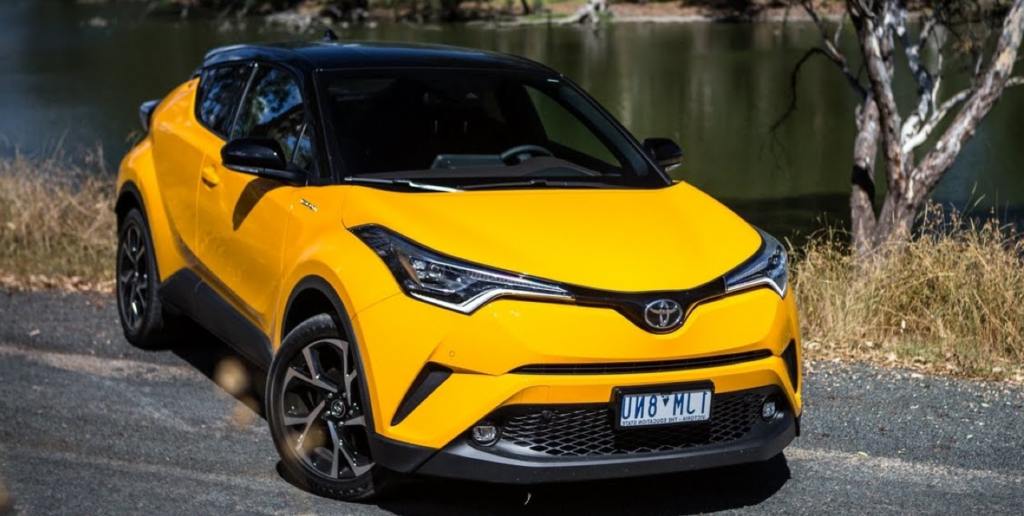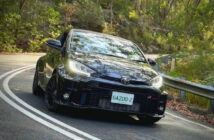Our Rating
The C-HR is a neat package of style, comfort and simplicity. The modern, edgy design turns heads and differentiates the C-HR from its competitors. Updates to the interior are needed, along with more power. The ride is comfortable and the AWD system works well to keep the car controlled.
-
Engine & Drivetrain
-
Performance
-
Fuel Economy
-
Interior
-
Gadgets & Technology
-
Safety
-
Ride & Comfort
-
Practicality
-
Affordability
-
Behind the Wheel
Engine
The C-HR is powered by a 1.2-litre turbocharged 4-cylinder engine. It puts out just 85kW of power and 185Nm of torque. Not an awful lot of power is needed to pull such a small form factor, however, more power is definitely needed to push the C-HR with ease.
Toyota is standing true to its CVT’s and the transmission in this mode was found to be fairly smooth and responsive. It even kicked down fairly quickly when dropping it into manual mode.
Larger displacement may have been worthwhile as the C-HR requires a lot of pedal to accelerate with ease. Most competitors have 100kW+ engines, which I would say is the minimum required to pull this type of car.
Owners won’t really worry about this, but it would be nice to have a bit more power like the competitors which mostly have over 100kW of power.
Performance
The C-HR redlines at around 5,500rpm, which is oddly low for a modern petrol powered car, but not surprising given the small form factor of the engine.
This model tested is the AWD version. On the dash, it has a little animation that shows how much power is going to each wheel. With this nifty little tool, we realised that not often at all did power go to the rear wheels, and if it did, it was at most 25-30%. This saves fuel and allows the car to use AWD only when needed.
The car did feel more planted than the 2WD version around corners, with a touch more confidence given the reduced possibility of understeer.
Mixed with more power, this AWD powertrain could be great! Larger displacement or a bigger turbo are a must with this car.
Fuel Economy
Toyota claims the consumption to be 6.4L/100km. We averaged around 7.7L/100km which is quite close to the advertised figure in comparison to other cars.
This 7.7L/100km figure comprised of around 60% motorway driving and 40% city driving. If that ratio favoured the city driving side more, it would easily rise to over 10L/100km.
After resetting the consumption figure indicator before going into the city, the figures were around the 9-10L mark. These are standard figures for this type of car, and with the small fuel tank, it seems as though fuel costs are cheap. Although a slightly larger fuel tank would have helped.
Interior & Technology
The Koba gets upgraded interiors in comparison to the stock C-HR.
The cheap Toyota hardware and software is on board, which is a big disappointments. The screen is dim, the designs old and the lack of Apple CarPlay and Android Auto is frustrating.
The Koba gets 17-inch alloys, a six-speaker stereo, dual-zone climate control, reversing camera, keyless entry and start, front and rear parking sensors, sat nav, fake leather trim, heated and folding mirrors, auto wipers and headlights and a space-saver spare tyre.
The stock C-HR gets similar features, just take away the upgraded rims, keyless entry and start, leather trim, heated mirrors and auto wipers and headlights. The price jump to the Koba is $4,300 which is an okay jump for the added features.
Boot space is 377 litres with seats up, or 1112 litres with seats down which is average for its class. This is not a vehicle that will easily fit 2 strollers, but it can comfortably fit passengers despite its small form.
Safety
The C-HR has a 5-Star ANCAP safety rating.
C-HR ships with seven airbags, ABS, stability and traction controls, forward AEB, active cruise control, lane departure warning, lane keep assist, blind spot monitoring, rear cross-traffic alert, a reversing camera and hill start assist.
Ride & Comfort
The ride is comfortable for its small size and the tires hold up well to glide over ditches and potholes. Passengers feel comfortable in the rear, even on longer journeys.
The AWD system makes the ride feel tighter and ever so slightly more agile, with understeer minimised. More power would make this ride more seemless, however those in the market for a mini SUV are not hunting for the best power to weight ratio.
Warranty & Servicing
Toyota offers their lame 3 year/100,000km warranty.
Capped-price servicing is great though; for the first five years you’ll pay $195 per service, and you only have to visit the dealer every 12 months or 15,000km.
Pricing
(2WD) 1.2LPULPCVT AUTO $28,990
(2WD) 1.2LPULP6 SP MAN $26,990
(AWD) 1.2LPULPCVT AUTO $30,990
KOBA (2WD) 1.2LPULPCVT AUTO $33,290
KOBA (AWD) 1.2LPULPCVT AUTO $35,290
Overall
The C-HR does well to hold its ground in the competitive SUV market, particularly with its competitive price point. Further upgrades to the interior would help the C-HR to potentially greater sales, however all Toyota’s are needing this.
The C-HR is a neat package of style, comfort and easability and that is the appeal for the C-HR.
ALL our videos of the C-HR AWD:
Full Walkthrough Review:
Tech Review:
Comprehensive Review and Drive:
POV Urban Test Drive:






